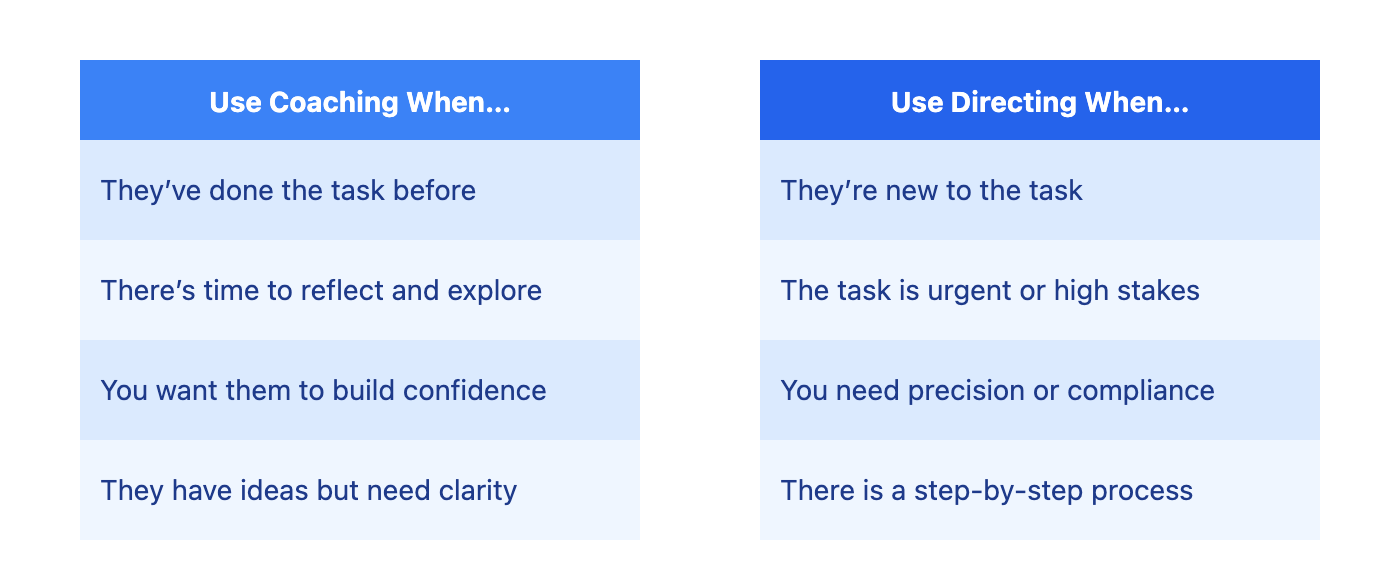Understanding when to coach and when to direct is a core part of building a strong leadership foundation. Coaching and directing are not opposing styles, but complementary tools you can use depending on the needs of your team and the demands of the situation. Coaching is about empowering your team to think for themselves, while directing is about providing clarity and structure when it’s needed most.
As you develop your coaching mindset, remember that your goal is to help your team become more capable and confident over time. Early on, you may need to direct more often, especially with new team members or unfamiliar tasks. As your team gains experience, you can shift toward coaching, encouraging them to take more ownership and initiative. The following table shows a good structure to follow for when you are lookingv to determine whether a moment is in need of coaching or direction:

The ability to switch between these approaches is what sets effective managers apart—helping you support your team’s growth without sacrificing results
Coaching is most effective when your team member has some experience with the task or challenge and would benefit from developing their own solutions. Use coaching to build problem-solving skills, confidence, and ownership. Look for opportunities to coach when:
- The situation allows for exploration, learning, and growth (e.g., problem-solving, reflecting on feedback, or planning next steps).
- The outcome is not urgent or high-risk.
- You want to encourage independent thinking.
In these moments, ask open-ended questions and encourage your team member to think through their options. For example, instead of immediately offering advice, you might say, "What approaches have you considered so far?" or "What do you think is the root of the challenge?" This signals that you trust their judgment and want to support their development.
Coaching is especially valuable in situations where there is more than one possible solution, or when you want to help your team member build confidence in their own decision-making. Over time, this approach helps your team become more resourceful and resilient, as they learn to tackle challenges independently.
Here’s a realistic example of how a manager can choose between coaching and directing in a 1:1 conversation:
- Jessica: I’m not sure how to handle the client’s feedback from yesterday’s meeting.
- Ryan: Would you like to talk through your ideas for responding, or would it be more helpful if I suggested a specific approach?
- Jessica: I have a couple of ideas, but I’m not sure which is best.
- Ryan: Great, let’s walk through your ideas together. What options are you considering?
- Jessica: I could either send a follow-up email addressing their concerns, or set up a call to clarify things.
- Ryan: Both are good options. What do you think would be most effective for this client?
In this exchange, Ryan first checks whether Jessica needs coaching or direction, then leans into coaching by encouraging Jessica to reflect and decide. Notice how Ryan’s questions help Jessica build confidence and take ownership of the solution.
Directing is necessary when there’s a clear right answer, when time is tight, or when safety, compliance, or quality is at stake. It’s also appropriate when someone is new to a task and needs step-by-step guidance. Use directing when:
- The task is urgent or high-stakes.
- There is only one correct or safe way to proceed.
- The team member is inexperienced with the task.
In these cases, be clear and specific about what needs to be done, and explain the reasoning if possible. For example, you might say, "For this report, please use the template I shared and submit it by Friday. Let me know if you have any questions as you go." This ensures clarity and helps your team member build confidence with new or critical tasks.
Directing is not about micromanaging, but about providing the structure and certainty needed to get important work done correctly and on time. It’s especially important in situations where mistakes could have serious consequences, or when your team member is still learning the basics.
By learning to flex between coaching and directing, you’ll empower your team to grow while keeping work on track. Practice noticing which approach fits each situation, and you’ll build both your team’s skills and your own confidence as a manager. Over time, you’ll find that your team becomes more self-sufficient, and you’ll be able to spend more time coaching and less time directing—creating a positive cycle of growth and achievement.
